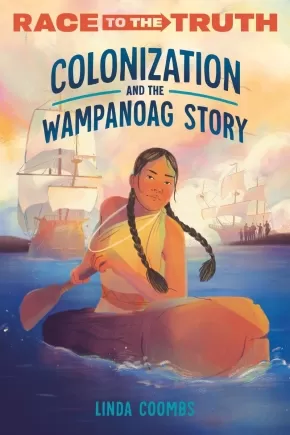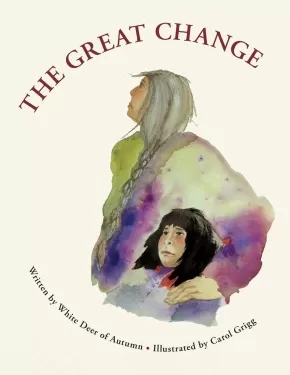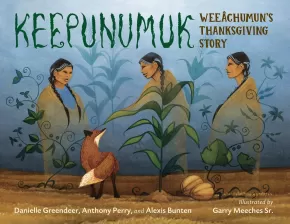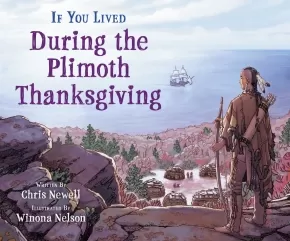
Wampanoag (Wôpanâak)
1
-
5
of
5 Results;
Sort By
Wôpanâak Seasons: Seeqan, Neepun, Keepun, Pup8n
$24.95
Format:
Hardcover
Text Content Territories:
Indigenous American; Native American; Wampanoag (Wôpanâak);
Grade Levels: Preschool; Kindergarten;
ISBN / Barcode: 9781926890418
Synopsis:
Synopsis:
In Wôpanâak Seasons a young Wampanoag child takes readers on a seasonal journey through Aquinnah, on Neope, known as Martha’s Vineyard. Spring brings the return of wildlife; summer brings beach adventures and clambakes; fall is for harvesting cranberries and making jams; and winter features cozy gatherings and heartfelt traditions. Each season showcases the rich cultural heritage of the Wampanoag people. With striking illustrations and lyrical prose, this book is about an appreciation of the land and the joy the joy of coming together with our community all year round.
Educator Information
Recommended for ages 3 to 5.
Additional Information
40 pages | 7.00" x 8.50" | Hardcover
Colonization and the Wampanoag Story
$11.99
Format:
Paperback
Text Content Territories:
Indigenous American; Native American; Wampanoag (Wôpanâak);
ISBN / Barcode: 9780593480434
Synopsis:
Synopsis:
Until now, you've only heard one side of the story: the "discovery" of America told by Christopher Columbus, the Pilgrims, and the Colonists. Here's the true story of America from the Indigenous perspective.
When you think about the beginning of the American story, what comes to mind? Three ships in 1492, or perhaps buckled hats and shoes stepping off of the Mayflower, ready to start a new country. But the truth is, Christopher Columbus, the Pilgrims, and the Colonists didn't arrive to a vast, empty land ready to be developed. They arrived to find people and communities living in harmony with the land they had inhabited for thousands of years, and they quickly disrupted everything they saw.
From its "discovery" by Europeans to the first Thanksgiving, the story of America's earliest days has been carefully misrepresented. Told from the perspective of the New England Indigenous Nations that these outsiders found when they arrived, this is the true story of how America as we know it today began.
Reviews
"A poignant and powerful look at identity, change, and resiliency." —Kirkus Reviews
Educator Information
Recommended for ages 10+.
Additional Information
272 pages | 5.50" x 8.31" | Paperback
The Great Change
$14.99
Artists:
Format:
Paperback
Text Content Territories:
Indigenous American; Native American;
ISBN / Barcode: 9781582708928
Synopsis:
Synopsis:
What happens when we die? In this beautifully illustrated Native American tale, a wise grandmother explains their people's understanding of death to her granddaughter as they work together on the land, for which they show an exemplary respect and love.
In this Native American tale, a wise grandmother explains the meaning of death, or the Great Change, to her questioning granddaughter. While going through their daily tasks in the Native way, taking from Mother Earth only what is needed and returning what is not used so as to replenish her, nine-year-old Wanba asks, “Why do fish have to die? Why does anything have to die? Why did Grandpa have to die?” Grandmother explains that just as a caterpillar “dies” only to become a beautiful butterfly, there is no “death” in the Circle of Life—only the Great Change.
This is a story of passing on tradition, culture, and wisdom to the next generation. It is a moving tale for everyone—child and adult—who wonders about what lies beyond this life.
Reviews
A gentle and sensitive story about mortality and the interconnectedness of generations and of life-forms that provides a nondoctrinal, reassuring response to a child's questions about the necessity of death. Grigg's watercolors are spare, with washes of brilliant color (cheering a potentially somber subject) against pure white pages. The characters are not romanticized, but the overall effect is delicate and impressionistic." —Patricia Dooley, University of Washington, Seattle Grades 3–6, School Library Journal
This wistful text, based on a Native American tale, ponders the meaning of life and death—reaching the sensible if daunting conclusion that one is impossible without the other.…Delicate pastel watercolors capture the story's essence on gossamer wings with a pleasing combination of sophistication and childish impressibility. —Publisher's Weekly
Educator Information
Recommended for ages 6 to 12.
Additional Information
32 pages | 8.50" x 11.00" | Paperback
Keepunumuk: Weeachumun's Thanksgiving Story
$22.99
Artists:
Format:
Hardcover
Text Content Territories:
Indigenous American; Native American; Wampanoag (Wôpanâak); Mashpee Wampanoag Tribe;
ISBN / Barcode: 9781623542900
Synopsis:
Synopsis:
In this Wampanoag story told in a Native tradition, two kids from the Mashpee Wampanoag tribe learn the story of Weeâchumun (corn) and the first Thanksgiving.
The Thanksgiving story that most Americans know celebrates the Pilgrims. But without members of the Wampanoag tribe who already lived on the land where the Pilgrims settled, the Pilgrims would never have made it through their first winter. And without Weeâchumun (corn), the Native people wouldn't have helped.
An important picture book honoring both the history and tradition that surrounds the story of the first Thanksgiving.
Reviews
"A Wamponoag grandmother plants her garden with weeâchumun (corn), beans, and squash, or the Three Sisters. When her grandchildren ask to hear the story of Thanksgiving, N8hkumuhs tells them that their people call it Keepunumuk, “the time of harvest,” and explains what really happened. The tale opens with Seagull warning Weeâchumun—depicted as a woman with a translucent body—of the Pilgrims’ arrival; Weeâchumun worries because many of the First Peoples who cared for her have gone to the Spirit World, and she fears this will be her last winter. Fox keeps an eye out and in spring tells Weeâchumun and her sisters that the newcomers endured a hard winter; many died. Weeâchumun and her sisters want to help: “We will send the First Peoples to help the newcomers.” The Wampanoag people teach the survivors how to plant corn, beans, and squash. The settlers hold a feast to celebrate the harvest; though it’s remembered by many as the first Thanksgiving, backmatter explains that because of the disease and warfare brought by the settlers, for the Wampanoag people, it is remembered as a day of mourning. Rich, saturated acrylics imbued with a touch of magic add to the vibrancy of this important, beautiful story. A much-needed Thanksgiving retelling that centers the Wamponoag people. (glossary, information on the Wampanoag map, recipes) (Picture book. 3-7)" —Kirkus, starred review
"This picture book features a contemporary Wampanoag grandmother and her grandchildren. N8hkumuhs shares the story of the Three Sisters—Corn, Beans, and Squash—and the first Thanksgiving, known as “Keepunumuk” by the Wampanoag people. The book transitions into a combination of history and storytelling about contact between the “First Peoples” and the newcomers. This format will be novel to some young children given the setting and timeframe of the story, though the book attempts to differentiate the parts that are the story by changing the typeface and including ethereal-like images of the Three Sisters. “Before You Begin” and “Important Words to Know” sections also provide context. Rich back matter includes more information about the Wampanoag tribes, a traditional recipe, and a photo and information about the real Maple and Quill, the grandchildren in the story. Overall, this story is a good addition for the historical knowledge of the first Thanksgiving from the Wampanoag viewpoint. VERDICT: A good choice for libraries striving to share Indigenous perspectives."— School Library Journal
Additional Information
32 pages | 11.38" x 8.81" | Hardcover
If You Lived During the Plimoth Thanksgiving
$11.99
Format:
Paperback
Text Content Territories:
Indigenous American; Native American; Wampanoag (Wôpanâak);
ISBN / Barcode: 9781338726367
Synopsis:
Synopsis:
What do you know about the thanksgiving feast at Plimoth?
What if you lived in a different time and place? What would you wear? What would you eat? How would your daily life be different?
Scholastic's If You Lived... series answers all of kids' most important questions about events in American history. With a question and answer format, kid-friendly artwork, and engaging information, this series is the perfect partner for the classroom and for history-loving readers.
What if you lived when the English colonists and the Wampanoag people shared a feast at Plimoth? What would you have worn? What would you have eaten? What was the true story of the feast that we now know as the first Thanksgiving and how did it become a national holiday?
Chris Newell answers all these questions and more in this comprehensive dive into the feast at Plimoth and the history leading up to it. Carefully crafted to explore both sides of this historical event, this book is a great choice for Thanksgiving units, and for teaching children about this popular holiday.
Reviews
"A welcome addition to the picture book history collection. ...The text does a remarkable job of giving larger context to the complexity of Indigenous life prior to colonization...This essential book should replace many established titles on the shelf." --School Library Journal (starred review)
"A measured corrective to pervasive myths about what is often referred to as the "first Thanksgiving." ...The lens Newell offers is a Native one, describing how the Wampanoag and other Native peoples received the English rather than the other way around. ...Essential." --Kirkus Reviews (starred review)
"A measured corrective to pervasive myths about what is often referred to as the "first Thanksgiving." ...The lens Newell offers is a Native one, describing how the Wampanoag and other Native peoples received the English rather than the other way around. ...Essential." --Kirkus Reviews (starred review)
Educator Information
Recommended for ages 7 to 10.
Additional Information
96 pages | 9.00" x 7.50" | Paperback
Sort By











